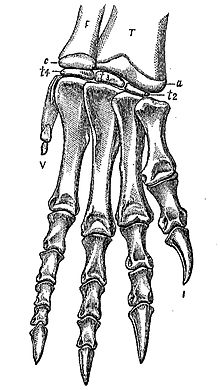
Ammosaurus
Background to the schools Wikipedia
SOS believes education gives a better chance in life to children in the developing world too. Before you decide about sponsoring a child, why not learn about different sponsorship charities first?
| Ammosaurus Temporal range: Early- Middle Jurassic |
|
|---|---|
 |
|
| Illustration of the foot bones | |
| Scientific classification |
|
| Kingdom: | Animalia |
| Phylum: | Chordata |
| Class: | Reptilia |
| Order: | Saurischia |
| Clade: | †Sauropodomorpha |
| Clade: | †Anchisauria |
| Genus: | †Ammosaurus Marsh, 1891 |
| Species: | † A. major |
| Binomial name | |
| Ammosaurus major (Marsh, 1889) |
|
| Synonyms | |
|
|
Ammosaurus (pron.: / ˌ æ m ɵ ˈ s ɔr ə s /; "sand lizard") is a genus of sauropodomorph dinosaur from the Early and Middle Jurassic Period of North America. At 4 meters (13 feet) in length, it was small compared to some other members of its suborder, which included the largest animals ever to walk the Earth. It was a versatile animal, able to move both bipedally and quadrupedally, and may have been omnivorous.
Naming
The generic name Ammosaurus is derived from the Greek words "ἄμμος" ("ammos" as "sandy ground") and "sauros" ("lizard"), referring to the sandstone in which it was found and its reptilian nature. There is one currently valid species (Ammosaurus major), which is so named because it is larger than Anchisaurus, of which it was originally considered a second species, Anchisaurus major. Famous American paleontologist Othniel Charles Marsh created this specific name in 1889. In 1891, Marsh created the new genus Ammosaurus for this species. He subsequently named another species of Anchisaurus in 1892: Anchisaurus solus, based on a juvenile specimen, YPM 209, from the same quarry Ammosaurus major was found in. In 1932 Friedrich von Huene renamed this to Ammosaurus solus. Scientists now consider it synonymous with Ammosaurus major.
Synonym with Anchisaurus?
The relationships of Ammosaurus with other dinosaurs are highly uncertain at this time. It is an early member of the suborder Sauropodomorpha and is most closely related to Anchisaurus, with which it may actually be synonymous. Different paleontologists consider Anchisaurus to be either a basal prosauropod (Galton & Upchurch, 2004), a basal sauropod (Yates & Kitching, 2003; Yates, 2004), or a sauropodomorph more derived than prosauropods but outside of Sauropoda.
Marsh originally described Ammosaurus major as Anchisaurus major, although he removed it to its own new genus only two years later. However, some recent studies have suggested that Ammosaurus and Anchisaurus are the same animal after all (Sereno, 1999; Yates, 2004). Other scientists prefer to keep the two genera separate due to anatomical differences in the pelvis and hind foot, although the two animals are still considered sister taxa (Galton & Upchurch, 2004).
Fossil discoveries
Fossils of Ammosaurus were originally discovered in the Portland Formation of the Newark Supergroup in the U.S. state of Connecticut. This formation preserves an arid environment with strong wet and dry seasons, from the Pliensbachian through to Toarcian stages of the Early Jurassic Period, roughly 190 to 176 million years ago. The original specimens were recovered from a sandstone quarry, which was used in the construction of the South Manchester Bridge in Connecticut. In fact, the holotype specimen, YPM 208, was on 20 October 1884 discovered by quarry workers. Unfortunately, it consists of only the rear half of the skeleton, as the block containing the front half had already been installed in the bridge when Marsh procured the fossil. In August 1969, the bridge was demolished, and some Ammosaurus remains, later catalogued as YPM 6282, were recovered by a team organised by John Ostrom. Three other incomplete skeletons of different ages are also known from Connecticut, but there is no known skull (Weishampel & Young, 1996). Ammosaurus is still found in Bajocian stage deposits of North America, making it one of the few "prosauropod" genera to survive into the Middle Jurassic (Weishampel et al., 2004).
Ammosaurus outside Connecticut
Ammosaurus remains have been reported from other parts of North America, but may not represent the species A. major, if they even represent the genus at all.
The Navajo Sandstone of Arizona is the same age as the Portland Formation, and has produced prosauropod remains that have been referred to as Ammosaurus (Galton, 1971). However, it is possible that these actually belong to the genus Massospondylus, otherwise known only from South Africa (Galton & Upchurch, 2004).
In the eastern Canadian province of Nova Scotia, scientists have unearthed prosauropods from the McCoy Brook Formation, which is about 200 to 197 million years old, from the Early Jurassic Hettangian stage. The Nova Scotia material provides clues about the diet of these animals. A large number of gastroliths, stones swallowed to grind up plant material in the gut, were found in the abdomen, as well as bone from the skull of a small sphenodont, Clevosaurus. This indicates that these dinosaurs were omnivorous, with a diet mainly consisting of plants but with an occasional supplement of meat (Shubin et al., 1994). However, these remains have never been fully described or illustrated and are only tentatively referred to Ammosaurus. Further study may either confirm or falsify this hypothesis.
